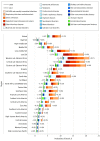Diseases, Injuries, and Risk Factors in Child and Adolescent Health, 1990 to 2017: Findings From the Global Burden of Diseases, Injuries, and Risk Factors 2017 Study
- PMID: 31034019
- PMCID: PMC6547084
- DOI: 10.1001/jamapediatrics.2019.0337
Diseases, Injuries, and Risk Factors in Child and Adolescent Health, 1990 to 2017: Findings From the Global Burden of Diseases, Injuries, and Risk Factors 2017 Study
Abstract
Importance: Understanding causes and correlates of health loss among children and adolescents can identify areas of success, stagnation, and emerging threats and thereby facilitate effective improvement strategies.
Objective: To estimate mortality and morbidity in children and adolescents from 1990 to 2017 by age and sex in 195 countries and territories.
Design, setting, and participants: This study examined levels, trends, and spatiotemporal patterns of cause-specific mortality and nonfatal health outcomes using standardized approaches to data processing and statistical analysis. It also describes epidemiologic transitions by evaluating historical associations between disease indicators and the Socio-Demographic Index (SDI), a composite indicator of income, educational attainment, and fertility. Data collected from 1990 to 2017 on children and adolescents from birth through 19 years of age in 195 countries and territories were assessed. Data analysis occurred from January 2018 to August 2018.
Exposures: Being under the age of 20 years between 1990 and 2017.
Main outcomes and measures: Death and disability. All-cause and cause-specific deaths, disability-adjusted life years, years of life lost, and years of life lived with disability.
Results: Child and adolescent deaths decreased 51.7% from 13.77 million (95% uncertainty interval [UI], 13.60-13.93 million) in 1990 to 6.64 million (95% UI, 6.44-6.87 million) in 2017, but in 2017, aggregate disability increased 4.7% to a total of 145 million (95% UI, 107-190 million) years lived with disability globally. Progress was uneven, and inequity increased, with low-SDI and low-middle-SDI locations experiencing 82.2% (95% UI, 81.6%-82.9%) of deaths, up from 70.9% (95% UI, 70.4%-71.4%) in 1990. The leading disaggregated causes of disability-adjusted life years in 2017 in the low-SDI quintile were neonatal disorders, lower respiratory infections, diarrhea, malaria, and congenital birth defects, whereas neonatal disorders, congenital birth defects, headache, dermatitis, and anxiety were highest-ranked in the high-SDI quintile.
Conclusions and relevance: Mortality reductions over this 27-year period mean that children are more likely than ever to reach their 20th birthdays. The concomitant expansion of nonfatal health loss and epidemiological transition in children and adolescents, especially in low-SDI and middle-SDI countries, has the potential to increase already overburdened health systems, will affect the human capital potential of societies, and may influence the trajectory of socioeconomic development. Continued monitoring of child and adolescent health loss is crucial to sustain the progress of the past 27 years.
Conflict of interest statement
Figures



References
-
- Dicker D, Nguyen G, Abate D, et al. ; GBD 2017 Mortality Collaborators . Global, regional, and national age-sex-specific mortality and life expectancy, 1950-2017: a systematic analysis for the Global Burden of Disease Study 2017. Lancet. 2018;392(10159):-. doi:10.1016/S0140-6736(18)31891-9 - DOI - PMC - PubMed
-
- GBD 2016 SDG Collaborators Measuring progress and projecting attainment on the basis of past trends of the health-related Sustainable Development Goals in 188 countries: an analysis from the Global Burden of Disease Study 2016. Lancet. 2017;390(10100):1423-1459. doi:10.1016/S0140-6736(17)32336-X - DOI - PMC - PubMed
-
- United Nations SDG Indicators: global indicator framework for the Sustainable Development Goals and targets of the 2030 Agenda for Sustainable Development. https://unstats.un.org/sdgs/indicators/indicators-list/. Published 2018. Accessed February 13, 2018.
Publication types
MeSH terms
Grants and funding
LinkOut - more resources
Full Text Sources
Medical
Miscellaneous

